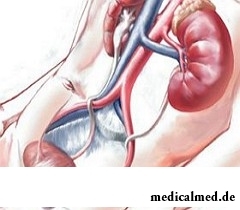





Nephrotic syndrome
 The nephrotic syndrome is a disease of which the expressed proteinuria, hypostases, a lipidemia, a hypoalbuminemia, increase in coagulability of blood, a lipiduriya are characteristic. Owing to various immune disturbances, disbolism, toxic influence, dystrophic processes in an organism occur the changes of walls of glomerular capillaries causing excessive filtering of proteins of plasma. Thus, the acute nephrotic syndrome is a consequence of the morbid conditions resulting in the increased permeability of a wall of glomerular capillaries.
The nephrotic syndrome is a disease of which the expressed proteinuria, hypostases, a lipidemia, a hypoalbuminemia, increase in coagulability of blood, a lipiduriya are characteristic. Owing to various immune disturbances, disbolism, toxic influence, dystrophic processes in an organism occur the changes of walls of glomerular capillaries causing excessive filtering of proteins of plasma. Thus, the acute nephrotic syndrome is a consequence of the morbid conditions resulting in the increased permeability of a wall of glomerular capillaries.
Main reasons for development of a nephrotic syndrome
The huge role in development of a nephrotic syndrome is played by immunologic mechanisms. Are the main reasons for development of primary neurotic syndrome:
- mezangialny proliferative glomerulonephritis;
- hymenoid glomerulonephritis (an idiopathic nephrotic syndrome at adults);
- hymenoid and proliferative glomerulonephritis;
- lipoid nephrosis (a nephropathy with the minimum changes, an idiopathic nephrotic syndrome at children);
- focal and segmented glomerulosclerosis.
The secondary nephrotic syndrome develops as a result:
- infectious diseases (leprosy, secondary syphilis, infectious endocarditis, hepatitis B, etc.);
- toxic and medicinal influences (heavy metals, non-steroidal anti-inflammatory drugs, Penicillaminum, antitoxins, captopril, etc.);
- general diseases of connecting fabric;
- heredo-familial diseases;
- other immune diseases;
- amyloidosis;
- pseudorheumatism;
- drepanocytic anemia;
- diabetes mellitus;
- system lupus erythematosus;
- sarcoidosis;
- tumors (leukosis, lymphoma, melanoma, carcinoma, lymphogranulomatosis);
- Shenleyna-Genokh's diseases.
It should be noted that the nephrotic syndrome at children occurs approximately four times more often than at adults.
Symptoms of a nephrotic syndrome
The main clinical symptom of a nephrotic syndrome are hypostases. Hypostases can gradually develop, but at some patients they arise very quickly. At first they appear in a face, a century, waists and generative organs, and afterwards extend to all hypodermic area, quite often reaching anasarca degree. At patients transsudata in serous cavities are observed: ascites, hydrothorax, hydrocardia. The look at patients becomes pale, with a bloated face and the swelled-up centuries. Despite strong pallor, anemia, as a rule, is absent at all or has moderate character.
If at the patient such symptom of a nephrotic syndrome as a renal failure develops, anemia becomes expressed. At ascites patients complain of digestion disturbance. Patients with a hydrocardia and a hydrothorax have a short wind. From cordial activity the following symptoms of a nephrotic syndrome are noted: emergence of systolic noise over a heart top, a priglushennost of tones, premature ventricular contraction, change of a final part of a ventricular complex, disturbance of a cordial rhythm which in the absence of other heart diseases can be defined as the nephrotic dystrophy of a myocardium resulting from disturbances of metabolism, electrolytic exchange and a hypoproteinemia.
The acute nephrotic syndrome is characterized by sudden manifestation of a proteinuria and hamaturia. Azotemia symptoms develop, there is a delay in an organism of water and salts, arterial hypertension.
Diagnosis of a nephrotic syndrome
Datas of laboratory play a crucial role in diagnosis of a nephrotic syndrome. At a nephrotic syndrome the increased SOE, sometimes to 50-60 mm is watched 1 h. Glomerular filtering, as a rule, normal or is a little increased. The relative density of urine is increased, and its maximum sizes can reach 1030-1060. The urocheras is poor, with the small maintenance of fatty and hyaline cylinders, fatty little bodies. The microhematuria is in certain cases observed. At the acute nephrotic syndrome which developed at patients with a hemorrhagic vasculitis against the background of a glomerulonephritis or a lupoid nephropathy the expressed hamaturia can be observed.
Actually, diagnosis of a nephrotic syndrome does not present special difficulties, and here identification of the main reason can bring to the doctor certain difficulties as the choice of adequate treatment of a nephrotic syndrome depends on it. For the purpose of identification of the reason the doctor can recommend to the patient to undergo full clinical, tool and laboratory inspection.
Current and forecast of a nephrotic syndrome
Many factors define complexity of a current and the forecast of this disease. It and age of patients, disease origin, clinical symptoms, morphological features, existence of complications and adequacy of treatment of a nephrotic syndrome. So, for example, a nephrotic syndrome at children (the lipoid nephrosis has the optimum forecast as it is inclined to remissions and well reacts to corticosteroids.
The forecast at primary hymenoid glomerulonephritis is much worse. As a rule, for the first 10 years at a third of adult patients the chronic renal failure and, as a result, a lethal outcome develops. At primary nephrotic syndrome which resulted from a nephropathy, the forecast is even worse. For 5-10 years at patients the heavy renal failure demanding a hemodialysis or transplantation of a kidney and arterial hypertension develop. The forecast of a secondary nephrotic syndrome is defined by a current and character of a basic disease.
Treatment of a nephrotic syndrome
Patients with this disease have to observe moderate physical activity as the hypokinesia promotes development of thromboses. The electrolyte-deficient diet is appointed, all products which contain sodium are minimized. The volume of the entered liquid should not exceed a daily urine on 20-30 ml. At the normal general caloric content of a diet the patient enters protein at the rate of 1 g on each kilogram of weight. Food has to be vitamin-rich also potassium.
 As a rule, at emergence of a renal failure hypostases decrease, then to the patient increase salt volume with the purpose to avoid its deficit, and also allow to accept more liquid. If the azotemia, amount of the entered protein is observed reduce to 0,6 g/kg of body weight a day. Treatment of a nephrotic syndrome albumine reasonablly only at patients with heavy orthostatic hypotension.
As a rule, at emergence of a renal failure hypostases decrease, then to the patient increase salt volume with the purpose to avoid its deficit, and also allow to accept more liquid. If the azotemia, amount of the entered protein is observed reduce to 0,6 g/kg of body weight a day. Treatment of a nephrotic syndrome albumine reasonablly only at patients with heavy orthostatic hypotension.
At severe hypostases to patients appoint diuretics. Acidum etacrynicum and furosemide which combine with veroshpirony or Triamterenum are most effective.
Recently use of antiagregant and heparin gained distribution at treatment of a nephrotic syndrome that is especially reasonable for the patients inclined to hypercoagulation.
Caries is the most widespread infectious disease in the world to which even flu cannot compete.

On health of the person physicians know about salutary action of animals long ago. About 7 thousand years ago great Hippocrates рекоменд...
Section: Articles about health
Sooner or later hair turn gray at all. Many people try to hide these changes, returning natural color of the hair by means of coloring, or considerably changing it for the purpose of creation of absolutely new image. All know that the gray hair is a sign приближающ...
Section: Articles about health
The pancreas performs two functions in a human body: release of enzymes without which digestion of carbohydrates, fats and proteins, and a producing hormones is impossible. The most important of them - insulin, is the main participant of carbohydrate metabolism normalizing processes of education and utilization of glucose, the main energy source for an organism....
Section: Articles about health
The sclera and mucous membrane of an eye are intensively supplied with blood vessels which problem - to sate nervous tissues of body to a pitata...
Section: Articles about health
Radiological methods of a research are applied in medicine more than hundred years, and thanks to them millions of lives were saved. In many cases without X-ray it is impossible to make exact idea of a condition of bodies and fabrics, it is correct to make the diagnosis. Those...
Section: Articles about health
Phobia – the persuasive fear of a certain contents shown in a specific situation against the will of the person. Concepts of a phobia and fear are similar, however if the fear is natural protective function of mentality, then the phobia is its deviation. So the person can feel the unaccountable, baseless fear accompanied with neurotic symptoms (perspiration, a shiver, a fever) before any ordinary phenomenon – for example, a trip by the subway or a simple dog....
Section: Articles about health
Many of us, probably, noticed more than once that from intellectual loadings at some point the brain as though "overheats" also "assimilation"...
Section: Articles about health
Bulimia and anorexia, are heavy deviations of a feeding behavior, become a cause of death of patients much more often than all other nervous breakdowns combined. In 60% of cases two illnesses accompany each other: patients feel horror before danger on...
Section: Articles about health
The drugs stopping or oppressing life activity of pathogenic microorganisms are widely applied in clinical practice from 40th years of the last century. Originally antibiotics were called only substances natural (animal, vegetable or microbic) origins, but over time this concept extended, and it includes also semi-synthetic and completely artificial antibacterial drugs....
Section: Articles about health
There comes the season of issues. Many Russians already dream of outdoor recreation, trips, beautiful seaside beaches....
Section: Articles about health
Statistically, can only one of ten of our compatriots brag of a decent condition of an oral cavity. Six teeth affected with caries are the share of the average Russian. For comparison, this indicator for Europeans almost six times exchanges...
Section: Articles about health
Statistically cystitis 25-30% of women up to 40 years have. With age this indicator raises, besides many do not get to statistics because do not see a doctor. The most sad that after the regular visits to doctors, long reception of antibiotics and life in the mode "it is necessary to take care" cystitis all the same is returned to a half of women. Symptoms of cystitis are unambiguous and it is impossible to confuse them with anything: bladder pain, burning at an urination, frequent desires to go to a toilet, a vynuzhd...
Section: Articles about health
Cystitis, or inflammation of a mucous membrane of a bladder, this very widespread disease, which, owing to some persons...
Section: Articles about health
Antibiotics - - it is possible to call the chemical compounds suppressing growth of bacteria the break in the field of medicine which allowed to save mankind from many diseases incurable earlier: tuberculosis, plague, syphilis and many others. A contribution of drugs to rescue of people from...
Section: Articles about health
High temperature - a frequent symptom of such widespread diseases as a SARS, quinsy, pneumonia, etc. To reduce heat, having facilitated a condition of the patient, doctors recommend to accept antipyretics, however their use is not always possible. Too frequent use of these drugs can lead to allergic reactions, and also overdose, causing poisoning. It happens also that there are no antipyretics simply in the house. In these situations it is pertinent to use it...
Section: Articles about health
Shops of household appliances offer us the huge choice of various devices for the house. Whether there are among this abundance devices which...
Section: Articles about health
All like to sing. Small children with pleasure are engaged in a vocal, not especially thinking of hit in a melody. Adults most often hesitate, being afraid to show lack of talents in this area, and it is vain: singing is very useful for health....
Section: Articles about health
Practice of hypnotic impact on consciousness of the person contains about two millennia. During this time scientists managed to learn a lot of things about a phenomenon of hypnosis and learned to facilitate a condition of the patients having heavy illnesses with its help....
Section: Articles about health
Food with the increased content of sugar is attractive to most of people - it is scientifically confirmed fact. Business here not in a nevozder...
Section: Articles about health
People know that thermal sources have salutary force long ago. Treatment by natural waters is one of the most ancient methods of disposal of the most different diseases. Bathtubs, souls, wrappings and inhalations, in combination with reception of water vnut...
Section: Articles about health
Long time antibiotics were considered as a panacea from all diseases and were appointed even at insignificant symptoms of an infection. Even now not everyone knows in what force of antibiotics how and when they should be accepted. Let's discredit 7 popular myths about such drugs....
Section: Articles about health
Small appetite at the child – the complaint which pediatricians should hear practically from each mother. Most often it is carried to разр...
Section: Articles about health
It is difficult to revaluate importance of kidneys for an organism. These bodies not only perform work on purification of blood of decomposition products and removal of excess liquid. They are responsible also for production of some hormones necessary for normality maintenance...
Section: Articles about health
One of the major chemical processes happening in a human body are oxidation reactions. They go with participation of fats and carbohydrates which we receive from food, and the oxygen getting to us from air. A main goal of such reactions is obtaining the energy necessary for life activity. Unfortunately, as a result of these processes dangerous by-products – so-called free radicals are allocated. To minimize harm which they can cause to the person neo...
Section: Articles about health
Stability of a hormonal background is one of the most important conditions of preservation of health of the woman. At the same time endocrine system –...
Section: Articles about health
Within several decades of our compatriots convinced that the use of butter nasty affects a condition of coronary vessels. As a result the reputation of a product was impaired thoroughly a little, and many almost ceased to include...
Section: Articles about health
Not everyone can brag of the shining Hollywood smile. Even the person who is regularly visiting the stomatologist and watching of oral cavities over health periodically has problems: enamel of teeth darkens under the influence of some products, on it the deposits giving to teeth a grayish or yellowish shade collect....
Section: Articles about health
